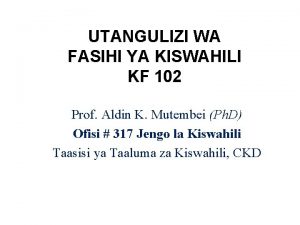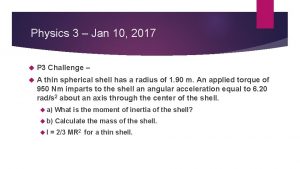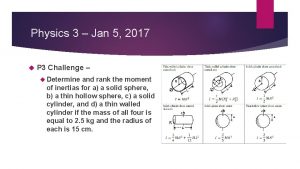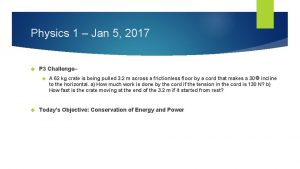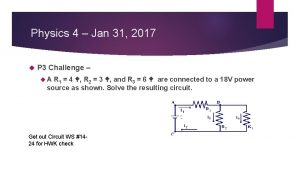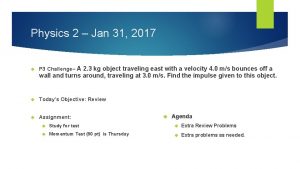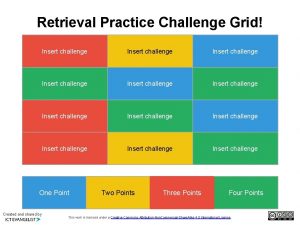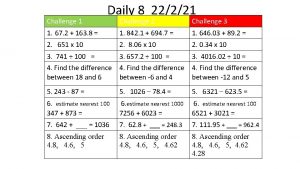Physics 1 Jan 10 2017 P 3 Challenge





















- Slides: 21

Physics 1 – Jan 10, 2017 P 3 Challenge– (Use energy methods. )A special operations soldier parachute jumps out of an airplane moving at 45. 0 m/s. How fast is the soldier moving when the parachute is opened 10. 5 m below the plane? (Assume air resistance is negligible during his descent. ) Today’s Objective: Review for Test on Jan 17 Get out the Cons of Energy problem set for a HW check.

Agenda, Assignment IB 2. 3 Work, Energy and Power Assignment: Agenda Omelet Review More Practice Problems for Exam 4 Homework Review Study for Test on Tues Jan 17 Time to work on Practice Problems

Physics Work defined Work is the product of a force through a distance. Positive work When the force and the displacement are in the same direction Adds to the energy of a system. Negative work When the force and the displacement are in opposite directions Removes energy from a system Note: friction always does negative work.

When is work NOT done? A perpendicular force does no work. Force applied without any change in position does no work.

Work at an angle – general case

Work by a variable force If a force is not constant over the distance, then you can plot how the force varies as a function of position. Still a force times a distance. The work done by the force over a distance is represented by the area between the graph and the x-axis on this graph. Ex: Work done by a spring force: W = ½ kx 2

Practice Problems A worker pulls a cart with a 45 N force at an angle of 25 to the horizontal over a distance of 1. 2 m. What work does the worker do on the cart? A 900 N mountain climber scales a 100 m cliff. How much work is done by the mountain climber? Angela uses a force of 25 Newtons to lift her grocery bag while doing 50 Joules of work. How far did she lift the grocery bags?

Energy What is energy? The ability to do work. Comes in two varieties: EK = kinetic energy Ep = potential energy Types of kinetic energy: motion, light, sound, thermal energy, electrical energy (all are a type of motion) Types of potential energy: gravitational, chemical, nuclear, spring, electrical potential (all are reversibly stored energy)

Kinetic Energy Kinetic energy – energy of motion Anything that is moving has kinetic energy EK = ½ mv 2 (in data booklet) Ex: What is the Kinetic Energy of a 150 kg object that is moving with a speed of 15 m/s? Ex: An object has a kinetic energy of 25 J and a mass of 34 kg , how fast is the object moving? Ex: An object moving with a speed of 35 m/s and has a kinetic energy of 1500 J, what is the mass of the object?

Work – K. E. Theorem The net work done on an object is equal to the change in kinetic energy for that object. Wnet = K. E = ½ mv 2 –½ mu 2 not in data booklet, need to know conceptually. a. The distance the helicopter traveled? b. The work done by the lifting force? c. The work done by the gravitational force? d. The net work done on the helicopter? e. The final kinetic energy of the helicopter? f. The final velocity of the helicopter? g. Verify this value using kinematics. Ex: A 500. kg light-weight helicopter ascends from the ground with an acceleration of 2. 00 m/s 2. Over a 5. 00 sec interval, what is

Change in energy for a system

Types of Systems Depending on how you draw the boundary of your system, there are three types of systems that can occur: Open, Closed and Isolated. An open system allows both matter and energy (in the form of work and/or heat) to flow over the border of the system. A closed system prohibits matter exchange over the border, but still allows a change in energy (heat and/or work) An isolated system prohibits both matter and energy exchange over the border of the system.

Conservation of Energy If you can identify an isolated system, then the E for the system will be zero. The result is a conservation of energy between any two states of the system over time. Many physical situations fall under this category. The notable exception is when there is an external force doing work on the system, usually in the form of friction. Note: This is a conservation of energy for a given system. Contrast this to the general idea of conservation of energy in the universe.

Conservative Forces and Potential E If a force does no net work during any closed loop sequence of events, then the force is conservative. If work is done, the force is nonconservative. Consider a swinging pendulum. The work done by gravity over a complete swing is zero. It has positive work as the pendulum falls, but does an equal amount of negative work as the pendulum rises again. Therefore, gravity is a conservative force. For every conservative force, there is a corresponding potential energy defined. Ug = – W g Ug = mgh (Note IB uses the general symbol Ep for all potential energies)

Conservative Forces and Potential E Consider a mass oscillating on a spring on a horizontal frictionless table. For one complete cycle, the spring does zero work. As the mass is being compressed, the spring does negative work, as it moves back to equilibrium it does an equal amount of positive work. As is becomes extended, the spring again does negative work until it turns around. As the mass returns to equilibrium an equal amount of positive work is done. Therefore, the spring force is a conservative force. Us = – W s Us = ½ kx 2 (Note IB uses the general symbol Ep for all potential energies)

Problem Solving with Cons of Energy As long as only conservative forces are present, then the total amount of energy in an isolated system will be constant. Problem solving strategy is to inventory the types of energy present at time 1 and set their sum equal to the inventory of types of energy present at time 2. The types of problems one can solve this way are similar to problems we previously solved with kinematics. Hint: Choose a convenient point to set Ep = 0 to make life easy. (Here: Ug= 0 at bottom of hill. ) Ex: A 55 kg sled starting at rest slides down a virtually frictionless hill. How fast will the sled be moving when it reaches the field 1. 2 m below? Ex: What if the sled had an initial speed of 1. 5 m/s?

When there is friction…. Friction is a nonconservative force that does negative work on a system. The change in energy of the system E = W is equal to the work done by friction. Or Ek 1 + EP 1 + Wnc = EK 2 + EP 2 Ex: A 62. 9 -kg downhill skier is moving with a speed of 12. 9 m/s as he starts his descent from a level plateau at 123 -m height to the ground below. The slope has an angle of 14. 1 degrees and a coefficient of friction of 0. 121. The skier coasts the entire descent without using his poles; upon reaching the bottom he continues to coast to a stop; the coefficient of friction along the level surface is 0. 623. How far will he coast along the level area at the bottom of the slope? (Use energy methods)

Power

Power problems Ex: Running late to class, Jerome runs up the stairs, elevating his 102 kg body a vertical distance of 2. 29 meters in a time of 1. 32 seconds at a constant speed. What power did Jerome generate? Ex: At what velocity is a car moving at the instant its engine is using 2, 250 watts to exert 130 N of force on the car’s wheels?

Efficiency

Exit Slip - Assignment Exit Slip- A certain celling fan uses 2400 J of energy to bring the 4. 3 kg blades from rest to a speed of 23 m/s. What is the efficiency of the fan motor? What’s Due on Jan 12? (Pending assignments to complete. ) Work on the Extra Practice Problems Study for the Test on Jan 17 What’s Next? (How to prepare for the next day) Read 2. 3 p 78 -95 about Work and Energy
 Valeo innovation challenge 2017 winners
Valeo innovation challenge 2017 winners Fallon sherrock smoking
Fallon sherrock smoking Why does it happen
Why does it happen University physics with modern physics fifteenth edition
University physics with modern physics fifteenth edition Physics ia research question ideas
Physics ia research question ideas Vce english bell curve
Vce english bell curve Mon tue wed thur fri sat sun
Mon tue wed thur fri sat sun Saasta astro quiz 2017 round 1 answers
Saasta astro quiz 2017 round 1 answers Astro quiz 2016 questions and answers
Astro quiz 2016 questions and answers Astro quiz round 2
Astro quiz round 2 Forrester identity management and governance
Forrester identity management and governance Szinkretizmus fejlődéslélektan
Szinkretizmus fejlődéslélektan Visual studio express 2017 download
Visual studio express 2017 download Mcdonald criteria 2017
Mcdonald criteria 2017 Utangulizi wa fasihi ya kiswahili pdf
Utangulizi wa fasihi ya kiswahili pdf Informe técnico 354-2019-servir/gpgsc
Informe técnico 354-2019-servir/gpgsc Arma conference 2017
Arma conference 2017 Doreen lioy kim
Doreen lioy kim Lipman apush
Lipman apush Epilepsy ilae 2017
Epilepsy ilae 2017 Testovanie 2017
Testovanie 2017 Hooghuis sportservice
Hooghuis sportservice














